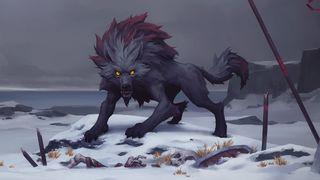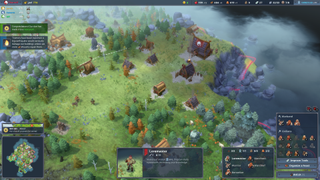
Northgard, even in its current Early Access state, is one of the better Viking games I’ve played in recent years. And I say that as someone who has an actual Viking raven banner flying above his desk. It plays similarly to old school Age of Empires while cutting back on micromanagement in the spirit of modern RTS design, and its understated art style captures the contrast between bleakness and wonder at the foundation of Norse mythology.
In the current Skirmish vs AI mode (the only one available, though competitive multiplayer and a campaign are planned), your empire starts with a handful food-producing villagers who forage your home region automatically to add to your stockpile. Once your labor force is larger than what is needed to feed itself, they can begin constructing buildings that will increase your population cap and train villagers into advanced jobs like woodcutters, scouts, and warriors.
The main deviation from the Age of Empires formula is that each map is split up into regions with defined borders. Once explored by a scout, they can be colonized for a lump sum of food (or conquered from a rival warlord if already claimed). Each has a fixed number of buildings it can support, and many also contain special resources like iron, stone, dense forests that increase your woodcutting output, or shorelines that allow you to launch Viking raids to seize off-map loot. Workers and military units are assigned to a region, where they will go about their business automatically, rather than having to constantly be given new orders. This let me focus more on high-level strategy and less on whether I needed to constantly reassign my wayward lumberjacks, which was refreshing.

The decision about when to go to war is never straightforward.
Northgard also models the reality that the passing of the seasons was a central factor in Viking life. The wheel of the year is always turning as you build, expand, and fight for glory. When it reaches winter, farms stop producing and your consumption of food and firewood goes up drastically. Military units operating outside your home territory also suffer combat penalties—despite what romantic portrayals might show, Vikings knew better than to go to war during the Scandinavian winter. This makes it necessary to maintain a stockpile of resources throughout the other months and time attacks carefully, leading to some interesting strategic decisions. You might discover an unspoiled region with rich iron deposits in October, and be forced to ask yourself if it’s worth spending the food to colonize it if it means half your population might get sick or die of starvation during the winter. Some years, you will be warned of an oncoming blizzard, making the winter even harsher and requiring even more drastic preparations.
Similarly, the decision about when to go to war is never straightforward. If I chose to attack on the first day of spring after a harsh snowstorm, I could expect my targets’ forces to be depleted, but my own were likely to be as well. The height of summer is prime war-making season, but everyone is at the height of their power and anyone I went after saw me coming a mile away. Fall raids tended to put me in a high risk, high reward situation. Getting bogged down in fighting right before the snows come could be disastrous, leading to my hapless retinue fighting in hostile land with significant debuffs and almost certainly perishing. But such a bold undertaking was sometimes able to catch my foes off-guard. On the other hand, playing defensive and building up a stockpile one year might allow you to weather winter in comfort and catch a more aggressive rival on the back foot the next year. It’s a simple and transparent mechanic, but one that brought a lot of new dimensions to my strategic thinking.

Just as the Vikings did much more than the pillaging they’re infamous for, Northgard offers several paths to victory. Some of them don’t even require you to bury axes in your enemies’ skulls. You can win a Trade victory by making a certain amount of money selling resources you have a surplus of to the other chieftains on the map. You can win a Prestige victory by performing great deeds to gain the title of King and building an associated wonder. A Lore victory requires you to seek out ruins and ancient standing stones to complete the modest tech tree and earn the blessings of the Norse gods. Or, you know, you can just kill everybody. I tried each path at least once. They all feel fleshed out and interesting, with their own unique concerns, which bodes well for replayability.

The current Early Access build features three playable clans with unique bonuses (my favorite being the martial-focused Wolf clan). But the devs plan to expand that roster in addition to adding new modes. I’m anxious to see Northgard grow and evolve, as it’s already engaging and easy to recommend as-is. It plays a little looser with the mythology stuff than I’d prefer; one of the non-player creep enemies is a “corrupted valkyrie,” which is kind of a stretch. But its overall portrayal of the goals and challenges of a Viking chieftain are fairly grounded and accurate, avoiding Hollywood stereotypes in favor of a feeling of historicity. If Odin played Early Access strategy games, I imagine he’d be pleased.
The biggest gaming news, reviews and hardware deals
Keep up to date with the most important stories and the best deals, as picked by the PC Gamer team.
Most Popular


